Analyzing Enron's Case in Relation to Ethical Corporate Governance and Sarbanes-Oxley Act, 2002
VerifiedAdded on 2023/01/05
|7
|1919
|75
AI Summary
This report analyzes the Enron scandal from the perspective of corporate governance and the Sarbanes-Oxley Act of 2002. It examines the causes of Enron's bankruptcy and the enactment of the Sarbanes-Oxley Act to prevent corporate fraud. The report highlights the importance of corporate governance in detecting and preventing unethical activities.
Contribute Materials
Your contribution can guide someone’s learning journey. Share your
documents today.
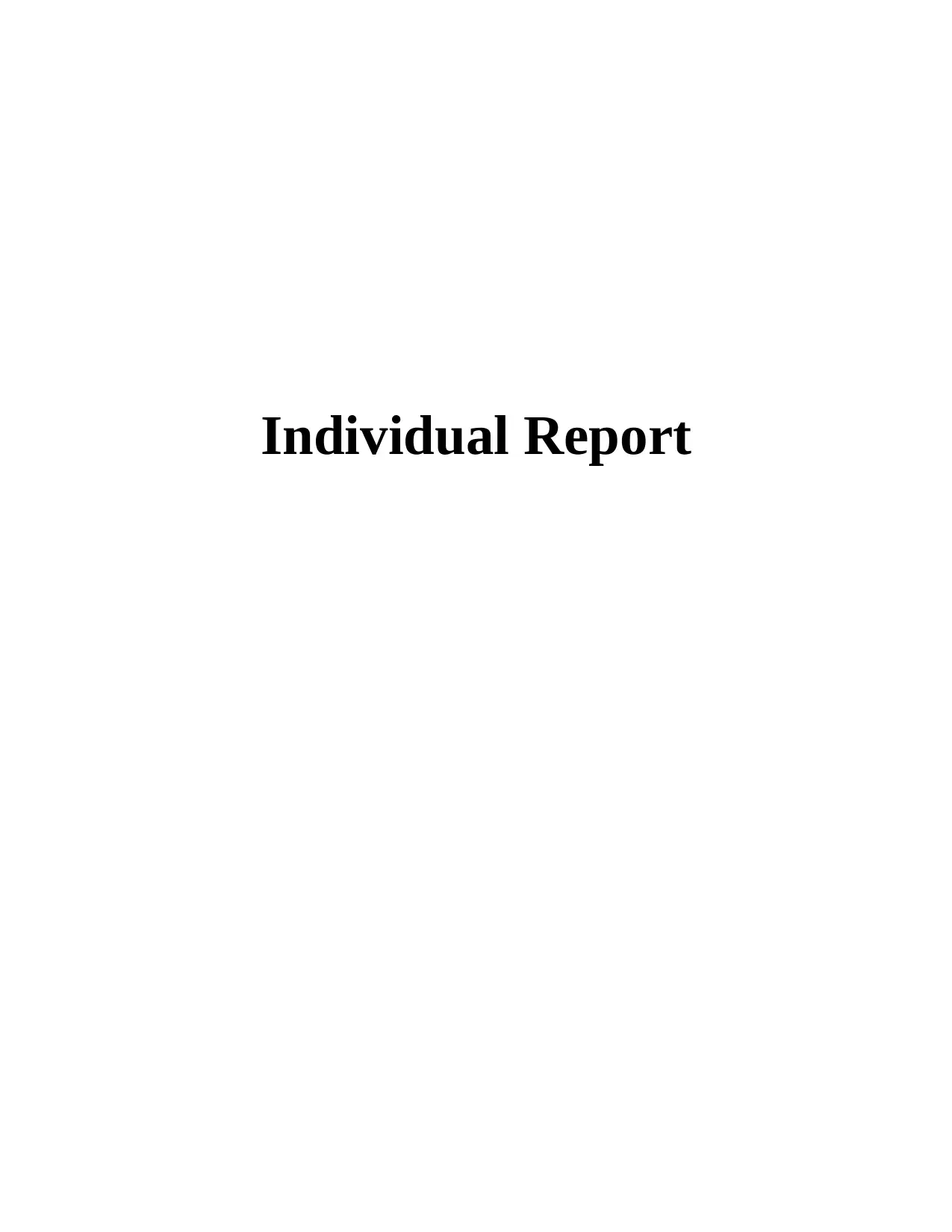
Individual Report
Secure Best Marks with AI Grader
Need help grading? Try our AI Grader for instant feedback on your assignments.

TABLE OF CONTENTS
INTRODUCTION...........................................................................................................................3
MAIN BODY...................................................................................................................................3
Analysing the Enron;'s case in relation to ethical corporate governance and Sabane Oxley Act,
2002.............................................................................................................................................3
Enactment of Sabanes Oxley Act 2002.......................................................................................5
CONCLUSION................................................................................................................................6
REFERENCES................................................................................................................................7
INTRODUCTION...........................................................................................................................3
MAIN BODY...................................................................................................................................3
Analysing the Enron;'s case in relation to ethical corporate governance and Sabane Oxley Act,
2002.............................................................................................................................................3
Enactment of Sabanes Oxley Act 2002.......................................................................................5
CONCLUSION................................................................................................................................6
REFERENCES................................................................................................................................7
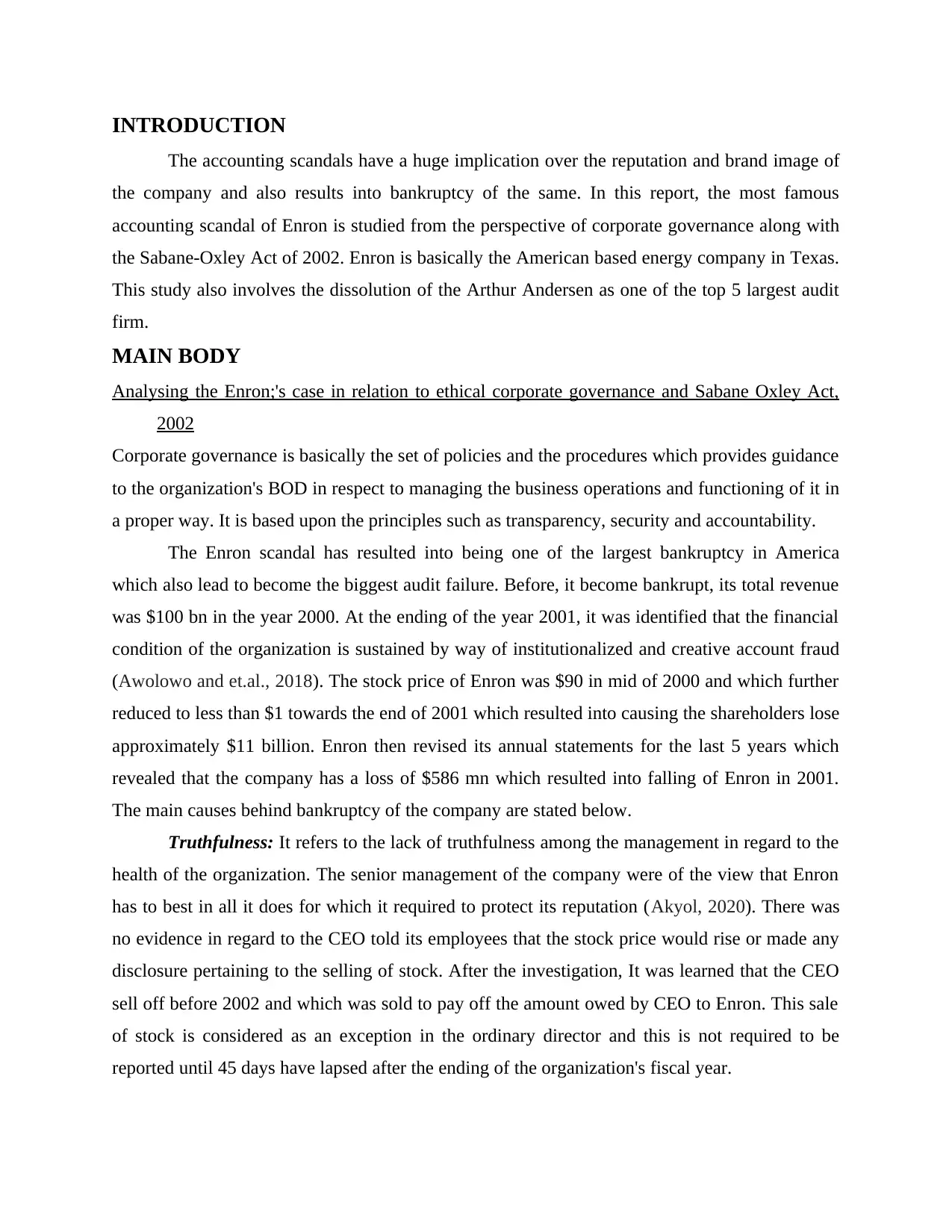
INTRODUCTION
The accounting scandals have a huge implication over the reputation and brand image of
the company and also results into bankruptcy of the same. In this report, the most famous
accounting scandal of Enron is studied from the perspective of corporate governance along with
the Sabane-Oxley Act of 2002. Enron is basically the American based energy company in Texas.
This study also involves the dissolution of the Arthur Andersen as one of the top 5 largest audit
firm.
MAIN BODY
Analysing the Enron;'s case in relation to ethical corporate governance and Sabane Oxley Act,
2002
Corporate governance is basically the set of policies and the procedures which provides guidance
to the organization's BOD in respect to managing the business operations and functioning of it in
a proper way. It is based upon the principles such as transparency, security and accountability.
The Enron scandal has resulted into being one of the largest bankruptcy in America
which also lead to become the biggest audit failure. Before, it become bankrupt, its total revenue
was $100 bn in the year 2000. At the ending of the year 2001, it was identified that the financial
condition of the organization is sustained by way of institutionalized and creative account fraud
(Awolowo and et.al., 2018). The stock price of Enron was $90 in mid of 2000 and which further
reduced to less than $1 towards the end of 2001 which resulted into causing the shareholders lose
approximately $11 billion. Enron then revised its annual statements for the last 5 years which
revealed that the company has a loss of $586 mn which resulted into falling of Enron in 2001.
The main causes behind bankruptcy of the company are stated below.
Truthfulness: It refers to the lack of truthfulness among the management in regard to the
health of the organization. The senior management of the company were of the view that Enron
has to best in all it does for which it required to protect its reputation (Akyol, 2020). There was
no evidence in regard to the CEO told its employees that the stock price would rise or made any
disclosure pertaining to the selling of stock. After the investigation, It was learned that the CEO
sell off before 2002 and which was sold to pay off the amount owed by CEO to Enron. This sale
of stock is considered as an exception in the ordinary director and this is not required to be
reported until 45 days have lapsed after the ending of the organization's fiscal year.
The accounting scandals have a huge implication over the reputation and brand image of
the company and also results into bankruptcy of the same. In this report, the most famous
accounting scandal of Enron is studied from the perspective of corporate governance along with
the Sabane-Oxley Act of 2002. Enron is basically the American based energy company in Texas.
This study also involves the dissolution of the Arthur Andersen as one of the top 5 largest audit
firm.
MAIN BODY
Analysing the Enron;'s case in relation to ethical corporate governance and Sabane Oxley Act,
2002
Corporate governance is basically the set of policies and the procedures which provides guidance
to the organization's BOD in respect to managing the business operations and functioning of it in
a proper way. It is based upon the principles such as transparency, security and accountability.
The Enron scandal has resulted into being one of the largest bankruptcy in America
which also lead to become the biggest audit failure. Before, it become bankrupt, its total revenue
was $100 bn in the year 2000. At the ending of the year 2001, it was identified that the financial
condition of the organization is sustained by way of institutionalized and creative account fraud
(Awolowo and et.al., 2018). The stock price of Enron was $90 in mid of 2000 and which further
reduced to less than $1 towards the end of 2001 which resulted into causing the shareholders lose
approximately $11 billion. Enron then revised its annual statements for the last 5 years which
revealed that the company has a loss of $586 mn which resulted into falling of Enron in 2001.
The main causes behind bankruptcy of the company are stated below.
Truthfulness: It refers to the lack of truthfulness among the management in regard to the
health of the organization. The senior management of the company were of the view that Enron
has to best in all it does for which it required to protect its reputation (Akyol, 2020). There was
no evidence in regard to the CEO told its employees that the stock price would rise or made any
disclosure pertaining to the selling of stock. After the investigation, It was learned that the CEO
sell off before 2002 and which was sold to pay off the amount owed by CEO to Enron. This sale
of stock is considered as an exception in the ordinary director and this is not required to be
reported until 45 days have lapsed after the ending of the organization's fiscal year.
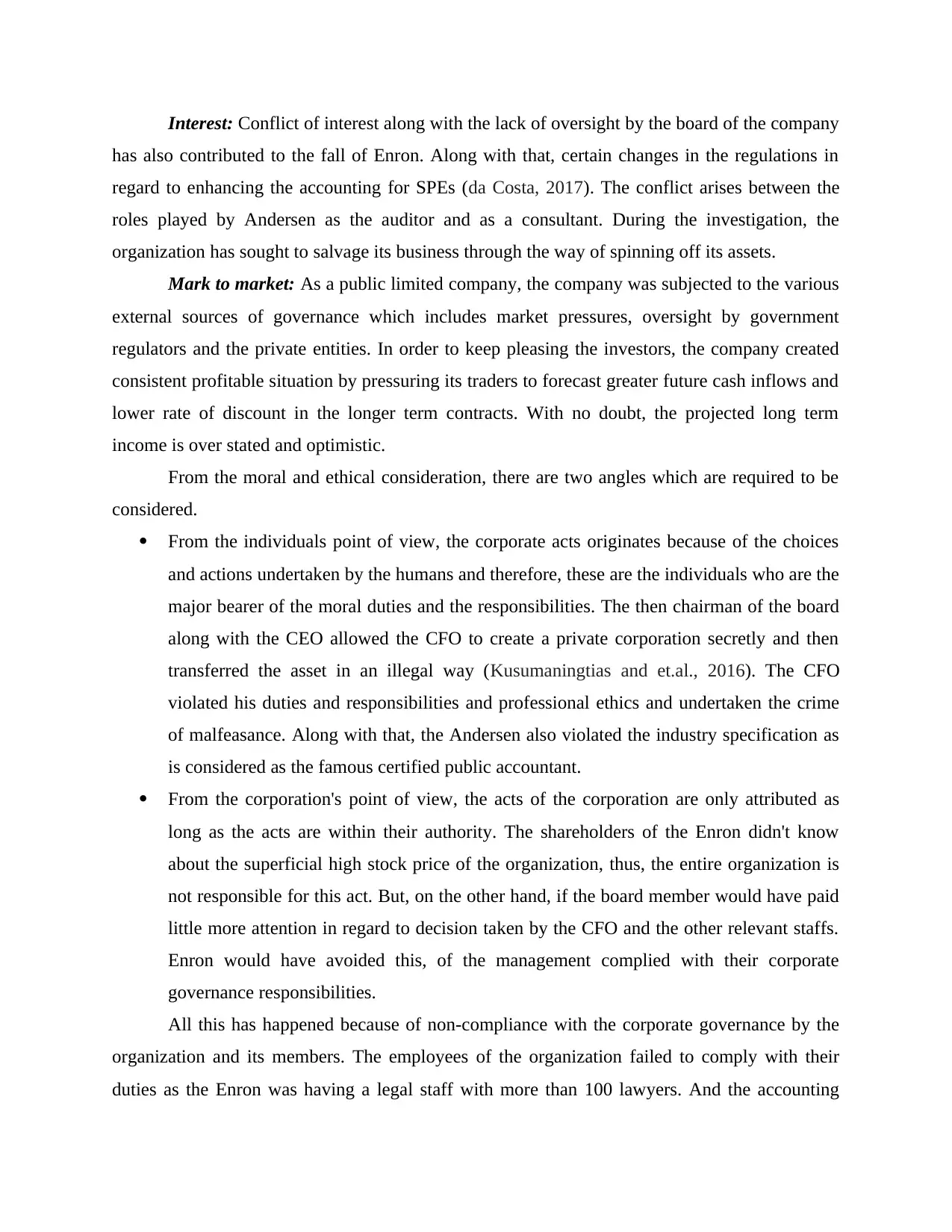
Interest: Conflict of interest along with the lack of oversight by the board of the company
has also contributed to the fall of Enron. Along with that, certain changes in the regulations in
regard to enhancing the accounting for SPEs (da Costa, 2017). The conflict arises between the
roles played by Andersen as the auditor and as a consultant. During the investigation, the
organization has sought to salvage its business through the way of spinning off its assets.
Mark to market: As a public limited company, the company was subjected to the various
external sources of governance which includes market pressures, oversight by government
regulators and the private entities. In order to keep pleasing the investors, the company created
consistent profitable situation by pressuring its traders to forecast greater future cash inflows and
lower rate of discount in the longer term contracts. With no doubt, the projected long term
income is over stated and optimistic.
From the moral and ethical consideration, there are two angles which are required to be
considered.
From the individuals point of view, the corporate acts originates because of the choices
and actions undertaken by the humans and therefore, these are the individuals who are the
major bearer of the moral duties and the responsibilities. The then chairman of the board
along with the CEO allowed the CFO to create a private corporation secretly and then
transferred the asset in an illegal way (Kusumaningtias and et.al., 2016). The CFO
violated his duties and responsibilities and professional ethics and undertaken the crime
of malfeasance. Along with that, the Andersen also violated the industry specification as
is considered as the famous certified public accountant.
From the corporation's point of view, the acts of the corporation are only attributed as
long as the acts are within their authority. The shareholders of the Enron didn't know
about the superficial high stock price of the organization, thus, the entire organization is
not responsible for this act. But, on the other hand, if the board member would have paid
little more attention in regard to decision taken by the CFO and the other relevant staffs.
Enron would have avoided this, of the management complied with their corporate
governance responsibilities.
All this has happened because of non-compliance with the corporate governance by the
organization and its members. The employees of the organization failed to comply with their
duties as the Enron was having a legal staff with more than 100 lawyers. And the accounting
has also contributed to the fall of Enron. Along with that, certain changes in the regulations in
regard to enhancing the accounting for SPEs (da Costa, 2017). The conflict arises between the
roles played by Andersen as the auditor and as a consultant. During the investigation, the
organization has sought to salvage its business through the way of spinning off its assets.
Mark to market: As a public limited company, the company was subjected to the various
external sources of governance which includes market pressures, oversight by government
regulators and the private entities. In order to keep pleasing the investors, the company created
consistent profitable situation by pressuring its traders to forecast greater future cash inflows and
lower rate of discount in the longer term contracts. With no doubt, the projected long term
income is over stated and optimistic.
From the moral and ethical consideration, there are two angles which are required to be
considered.
From the individuals point of view, the corporate acts originates because of the choices
and actions undertaken by the humans and therefore, these are the individuals who are the
major bearer of the moral duties and the responsibilities. The then chairman of the board
along with the CEO allowed the CFO to create a private corporation secretly and then
transferred the asset in an illegal way (Kusumaningtias and et.al., 2016). The CFO
violated his duties and responsibilities and professional ethics and undertaken the crime
of malfeasance. Along with that, the Andersen also violated the industry specification as
is considered as the famous certified public accountant.
From the corporation's point of view, the acts of the corporation are only attributed as
long as the acts are within their authority. The shareholders of the Enron didn't know
about the superficial high stock price of the organization, thus, the entire organization is
not responsible for this act. But, on the other hand, if the board member would have paid
little more attention in regard to decision taken by the CFO and the other relevant staffs.
Enron would have avoided this, of the management complied with their corporate
governance responsibilities.
All this has happened because of non-compliance with the corporate governance by the
organization and its members. The employees of the organization failed to comply with their
duties as the Enron was having a legal staff with more than 100 lawyers. And the accounting
Secure Best Marks with AI Grader
Need help grading? Try our AI Grader for instant feedback on your assignments.
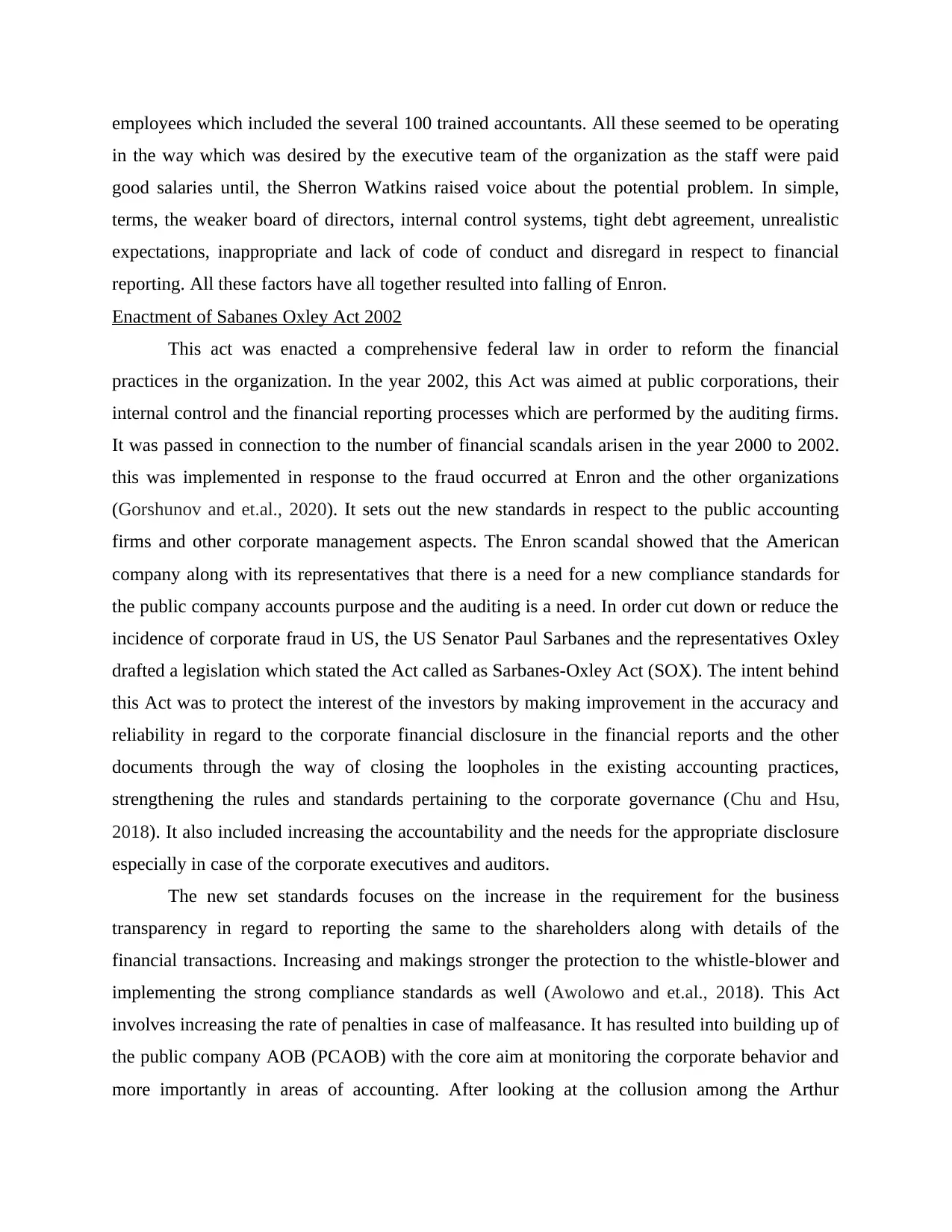
employees which included the several 100 trained accountants. All these seemed to be operating
in the way which was desired by the executive team of the organization as the staff were paid
good salaries until, the Sherron Watkins raised voice about the potential problem. In simple,
terms, the weaker board of directors, internal control systems, tight debt agreement, unrealistic
expectations, inappropriate and lack of code of conduct and disregard in respect to financial
reporting. All these factors have all together resulted into falling of Enron.
Enactment of Sabanes Oxley Act 2002
This act was enacted a comprehensive federal law in order to reform the financial
practices in the organization. In the year 2002, this Act was aimed at public corporations, their
internal control and the financial reporting processes which are performed by the auditing firms.
It was passed in connection to the number of financial scandals arisen in the year 2000 to 2002.
this was implemented in response to the fraud occurred at Enron and the other organizations
(Gorshunov and et.al., 2020). It sets out the new standards in respect to the public accounting
firms and other corporate management aspects. The Enron scandal showed that the American
company along with its representatives that there is a need for a new compliance standards for
the public company accounts purpose and the auditing is a need. In order cut down or reduce the
incidence of corporate fraud in US, the US Senator Paul Sarbanes and the representatives Oxley
drafted a legislation which stated the Act called as Sarbanes-Oxley Act (SOX). The intent behind
this Act was to protect the interest of the investors by making improvement in the accuracy and
reliability in regard to the corporate financial disclosure in the financial reports and the other
documents through the way of closing the loopholes in the existing accounting practices,
strengthening the rules and standards pertaining to the corporate governance (Chu and Hsu,
2018). It also included increasing the accountability and the needs for the appropriate disclosure
especially in case of the corporate executives and auditors.
The new set standards focuses on the increase in the requirement for the business
transparency in regard to reporting the same to the shareholders along with details of the
financial transactions. Increasing and makings stronger the protection to the whistle-blower and
implementing the strong compliance standards as well (Awolowo and et.al., 2018). This Act
involves increasing the rate of penalties in case of malfeasance. It has resulted into building up of
the public company AOB (PCAOB) with the core aim at monitoring the corporate behavior and
more importantly in areas of accounting. After looking at the collusion among the Arthur
in the way which was desired by the executive team of the organization as the staff were paid
good salaries until, the Sherron Watkins raised voice about the potential problem. In simple,
terms, the weaker board of directors, internal control systems, tight debt agreement, unrealistic
expectations, inappropriate and lack of code of conduct and disregard in respect to financial
reporting. All these factors have all together resulted into falling of Enron.
Enactment of Sabanes Oxley Act 2002
This act was enacted a comprehensive federal law in order to reform the financial
practices in the organization. In the year 2002, this Act was aimed at public corporations, their
internal control and the financial reporting processes which are performed by the auditing firms.
It was passed in connection to the number of financial scandals arisen in the year 2000 to 2002.
this was implemented in response to the fraud occurred at Enron and the other organizations
(Gorshunov and et.al., 2020). It sets out the new standards in respect to the public accounting
firms and other corporate management aspects. The Enron scandal showed that the American
company along with its representatives that there is a need for a new compliance standards for
the public company accounts purpose and the auditing is a need. In order cut down or reduce the
incidence of corporate fraud in US, the US Senator Paul Sarbanes and the representatives Oxley
drafted a legislation which stated the Act called as Sarbanes-Oxley Act (SOX). The intent behind
this Act was to protect the interest of the investors by making improvement in the accuracy and
reliability in regard to the corporate financial disclosure in the financial reports and the other
documents through the way of closing the loopholes in the existing accounting practices,
strengthening the rules and standards pertaining to the corporate governance (Chu and Hsu,
2018). It also included increasing the accountability and the needs for the appropriate disclosure
especially in case of the corporate executives and auditors.
The new set standards focuses on the increase in the requirement for the business
transparency in regard to reporting the same to the shareholders along with details of the
financial transactions. Increasing and makings stronger the protection to the whistle-blower and
implementing the strong compliance standards as well (Awolowo and et.al., 2018). This Act
involves increasing the rate of penalties in case of malfeasance. It has resulted into building up of
the public company AOB (PCAOB) with the core aim at monitoring the corporate behavior and
more importantly in areas of accounting. After looking at the collusion among the Arthur
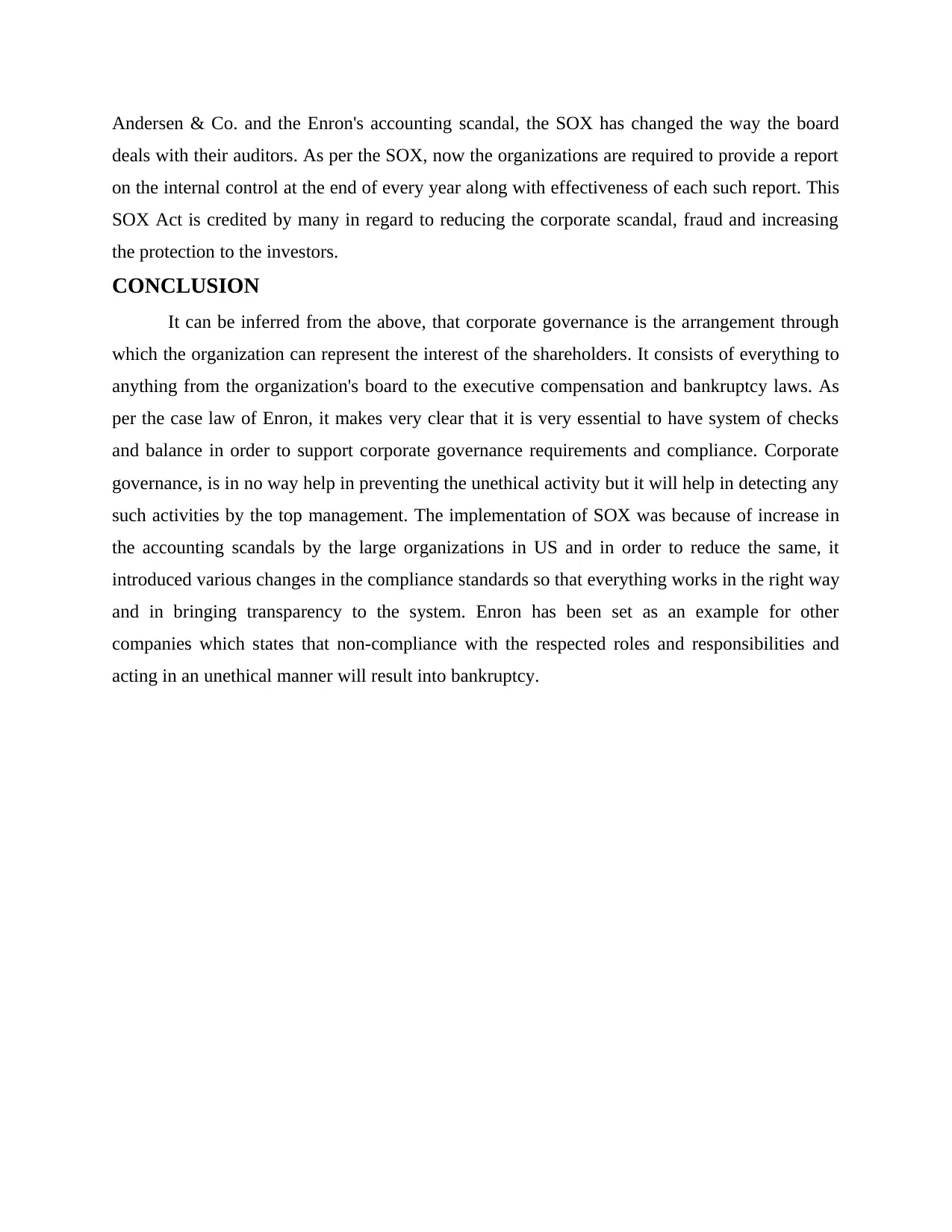
Andersen & Co. and the Enron's accounting scandal, the SOX has changed the way the board
deals with their auditors. As per the SOX, now the organizations are required to provide a report
on the internal control at the end of every year along with effectiveness of each such report. This
SOX Act is credited by many in regard to reducing the corporate scandal, fraud and increasing
the protection to the investors.
CONCLUSION
It can be inferred from the above, that corporate governance is the arrangement through
which the organization can represent the interest of the shareholders. It consists of everything to
anything from the organization's board to the executive compensation and bankruptcy laws. As
per the case law of Enron, it makes very clear that it is very essential to have system of checks
and balance in order to support corporate governance requirements and compliance. Corporate
governance, is in no way help in preventing the unethical activity but it will help in detecting any
such activities by the top management. The implementation of SOX was because of increase in
the accounting scandals by the large organizations in US and in order to reduce the same, it
introduced various changes in the compliance standards so that everything works in the right way
and in bringing transparency to the system. Enron has been set as an example for other
companies which states that non-compliance with the respected roles and responsibilities and
acting in an unethical manner will result into bankruptcy.
deals with their auditors. As per the SOX, now the organizations are required to provide a report
on the internal control at the end of every year along with effectiveness of each such report. This
SOX Act is credited by many in regard to reducing the corporate scandal, fraud and increasing
the protection to the investors.
CONCLUSION
It can be inferred from the above, that corporate governance is the arrangement through
which the organization can represent the interest of the shareholders. It consists of everything to
anything from the organization's board to the executive compensation and bankruptcy laws. As
per the case law of Enron, it makes very clear that it is very essential to have system of checks
and balance in order to support corporate governance requirements and compliance. Corporate
governance, is in no way help in preventing the unethical activity but it will help in detecting any
such activities by the top management. The implementation of SOX was because of increase in
the accounting scandals by the large organizations in US and in order to reduce the same, it
introduced various changes in the compliance standards so that everything works in the right way
and in bringing transparency to the system. Enron has been set as an example for other
companies which states that non-compliance with the respected roles and responsibilities and
acting in an unethical manner will result into bankruptcy.
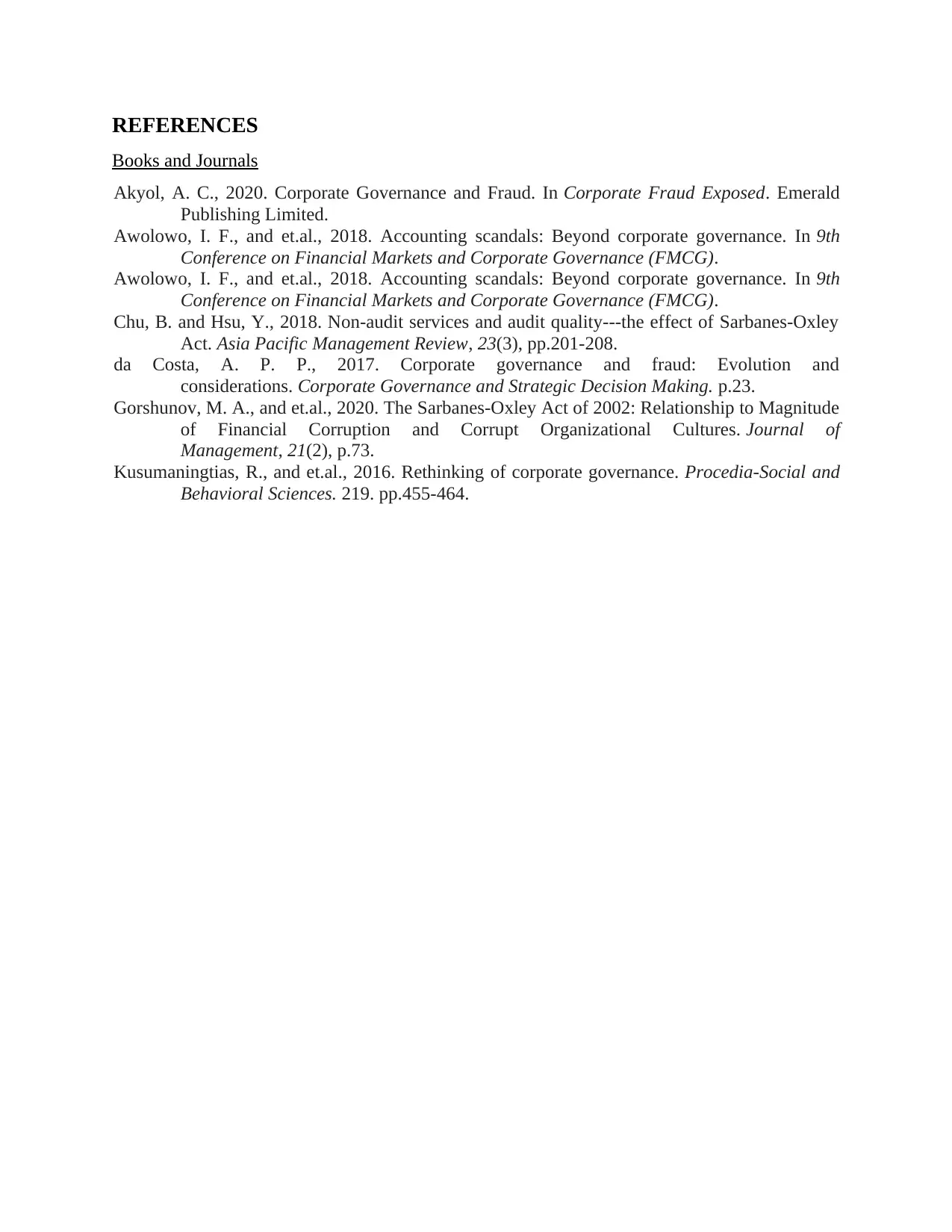
REFERENCES
Books and Journals
Akyol, A. C., 2020. Corporate Governance and Fraud. In Corporate Fraud Exposed. Emerald
Publishing Limited.
Awolowo, I. F., and et.al., 2018. Accounting scandals: Beyond corporate governance. In 9th
Conference on Financial Markets and Corporate Governance (FMCG).
Awolowo, I. F., and et.al., 2018. Accounting scandals: Beyond corporate governance. In 9th
Conference on Financial Markets and Corporate Governance (FMCG).
Chu, B. and Hsu, Y., 2018. Non-audit services and audit quality---the effect of Sarbanes-Oxley
Act. Asia Pacific Management Review, 23(3), pp.201-208.
da Costa, A. P. P., 2017. Corporate governance and fraud: Evolution and
considerations. Corporate Governance and Strategic Decision Making. p.23.
Gorshunov, M. A., and et.al., 2020. The Sarbanes-Oxley Act of 2002: Relationship to Magnitude
of Financial Corruption and Corrupt Organizational Cultures. Journal of
Management, 21(2), p.73.
Kusumaningtias, R., and et.al., 2016. Rethinking of corporate governance. Procedia-Social and
Behavioral Sciences. 219. pp.455-464.
Books and Journals
Akyol, A. C., 2020. Corporate Governance and Fraud. In Corporate Fraud Exposed. Emerald
Publishing Limited.
Awolowo, I. F., and et.al., 2018. Accounting scandals: Beyond corporate governance. In 9th
Conference on Financial Markets and Corporate Governance (FMCG).
Awolowo, I. F., and et.al., 2018. Accounting scandals: Beyond corporate governance. In 9th
Conference on Financial Markets and Corporate Governance (FMCG).
Chu, B. and Hsu, Y., 2018. Non-audit services and audit quality---the effect of Sarbanes-Oxley
Act. Asia Pacific Management Review, 23(3), pp.201-208.
da Costa, A. P. P., 2017. Corporate governance and fraud: Evolution and
considerations. Corporate Governance and Strategic Decision Making. p.23.
Gorshunov, M. A., and et.al., 2020. The Sarbanes-Oxley Act of 2002: Relationship to Magnitude
of Financial Corruption and Corrupt Organizational Cultures. Journal of
Management, 21(2), p.73.
Kusumaningtias, R., and et.al., 2016. Rethinking of corporate governance. Procedia-Social and
Behavioral Sciences. 219. pp.455-464.
1 out of 7
Related Documents
Your All-in-One AI-Powered Toolkit for Academic Success.
+13062052269
info@desklib.com
Available 24*7 on WhatsApp / Email
![[object Object]](/_next/static/media/star-bottom.7253800d.svg)
Unlock your academic potential
© 2024 | Zucol Services PVT LTD | All rights reserved.





